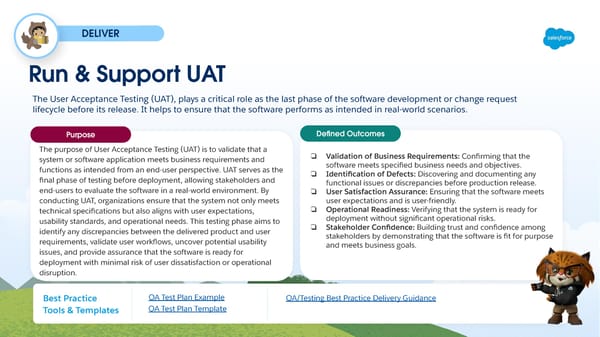DELIVER Run & Support UAT The User Acceptance Testing (UAT), plays a critical role as the last phase of the software development or change request lifecycle before its release. It helps to ensure that the software performs as intended in real-world scenarios. Defined Outcomes Purpose The purpose of User Acceptance Testing (UAT) is to validate that a ❏ Validation of Business Requirements: Confirming that the system or software application meets business requirements and software meets specified business needs and objectives. functions as intended from an end-user perspective. UAT serves as the ❏ Identification of Defects: Discovering and documenting any final phase of testing before deployment, allowing stakeholders and functional issues or discrepancies before production release. end-users to evaluate the software in a real-world environment. By ❏ User Satisfaction Assurance: Ensuring that the software meets user expectations and is user-friendly. conducting UAT, organizations ensure that the system not only meets ❏ Operational Readiness: Verifying that the system is ready for technical specifications but also aligns with user expectations, deployment without significant operational risks. usability standards, and operational needs. This testing phase aims to ❏ Stakeholder Confidence: Building trust and confidence among identify any discrepancies between the delivered product and user stakeholders by demonstrating that the software is fit for purpose requirements, validate user workflows, uncover potential usability and meets business goals. Salesforce Adoption Dashboards issues, and provide assurance that the software is ready for deployment with minimal risk of user dissatisfaction or operational disruption. QA Test Plan Example QA/Testing Best Practice Delivery Guidance Best Practice QA Test Plan Template Tools & Templates
 A Partner Readiness Guide to Deliver Like Salesforce Page 100 Page 102
A Partner Readiness Guide to Deliver Like Salesforce Page 100 Page 102